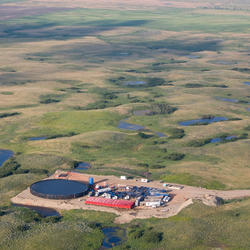Energy Production Materials in the Environment
Energy Production Materials in the Environment
Filter Total Items: 13
Behavioral Toxicology Core Technology Team
About the Research. The Environmental Health Program supports scientists in the Behavioral Toxicology Core Technology Team (CTT) at the Columbia Environmental Research Center. The scientists identify how contaminants alter the behavior of organisms and what implication those changes may have on individuals, populations, and communities.
Microbial Biogeochemistry Core Technology Team
About the Research The Microbial Biogeochemistry Laboratory Core Technology Team (CTT) as part of the Environmental Health Program focuses on environmental questions in aquatic systems (sediment and water) involving the linkages between major biogeochemical cycles (those involving carbon, sulfur, iron and nitrogen) and those associated with contaminants of concern.
Hydrogeophysics Core Technology Team
About the Research. The Hydrogeophysics Core Technology Team (CTT) as part of the Environmental Health Program specializes in locating and quantifying exchanges of groundwater and surface water, along with characterizing geologic structure and mapping hydrologic connectivity across varied landscapes.
Geochemical Signatures of Oil and Gas Wastewater from an Accidental Release Detected in Stream Sediment and Pore Waters Two Years Post Spill
Scientists identified geochemical signatures of wastewater in Blacktail Creek, North Dakota, as a result of a 2015 pipeline leak. They demonstrated that environmental signatures from wastewater spills are persistent within a short (1-3 year) time frame, can enter the creek through subsurface pathways, and can create the potential for extended environmental exposures.
Energy Integrated Science Team
The Energy Lifecycle Integrated Science Team focuses on the potential for contaminant exposures in the environment that might originate from energy resource activities including, extraction, production, transportation, storage, extraction, waste management and restoration. Perceived health risks to humans and other organisms will be distinguished from actual risks, if any. If actual risks are...
Technique Used to Distinguish Natural Background from Human-Caused Enrichment of Trace Elements in Soils
Human activities can enrich toxic trace elements like uranium and arsenic in the environment, but these elements also are from natural sources and occur at background levels. Scientists utilized a technique that identifies the background and the elemental fingerprint of human-caused enrichment and tested the new technique on data collected near uranium mines in Arizona.
Framework for Examining Stream Ecosystem Health in Areas of Shale Gas Development—A Multi-Parameter Watershed-Based Case Study in Pennsylvania
In a case study of 25 headwater streams in Pennsylvania, no statistically significant associations were determined between shale gas development and geochemical tracers of produced waters or measures of microbial and macroinvertebrate community composition. Although the results are specific to the region studied, the integrated biological and geochemical framework provides a tool for examining...
Amphibians Exposed to Oil and Gas Co-Produced Wastewaters: Differentiating the Actual and the Perceived Inorganic Contaminant Hazards — Prairie Pothole Region
Chloride and metals in oil and gas co-produced wastewaters (often referred to as brines) are commonly perceived as contaminant hazards for biota. Amphibian abundance in the Prairie Pothole Region affected by historic oil and gas co-produced wastewaters was lower in wetlands with high concentrations of chloride indicating an actual contaminant hazard. Metals detected in sediments and amphibian...
Can There be Unintended Benefits when Wastewater Treatment Infrastructure is Upgraded?
Science from the U.S. Geological Survey (USGS) and other entities has shown that a mixture of natural and synthetic estrogens and other similar chemicals are discharged from wastewater treatment plants (WWTPs) to streams and rivers.
Are Spills Associated with Deep Well Injection of Wastewater from Oil and Gas Operations a Health Hazard?
Our specialized teams of hydrologists, chemists, biologists, and geologists worked together in the New River Gorge National River watershed to answer this question. Wastewater generated in association with oil and gas operations at this site is managed by injection in deep wells designed to safely dispose and contain contaminants in deep geologic formations. Contaminants associated with oil and...
Environmental Chemistry Core Technology Team
About the Research The Environmental Chemistry Laboratory Core Technology Team (CTT) as part of the Environmental Health Program develops and applies innovative methods of sampling and analysis to answer critical questions about the occurrence, distribution, fate and transport, and biological exposure of chemical in all environmental matrices (water, air, tissues, sediments, and others).
Cyclical Mobilization and Attenuation of Naturally Occurring Arsenic in an Underground Petroleum Plume
Scientists found that naturally occurring arsenic in aquifer sediments was mobilized into groundwater and attenuated through reattachment to sediments within an underground petroleum plume. Understanding these patterns identifies anthropogenic factors that affect arsenic presence and magnitude in groundwater.













